WARNING: THIS POST MAY CONTAIN TEXT AND PHOTOS THAT SOME MIGHT CONSIDER INAPPROPRIATE FOR PEOPLE UNDER 18 OR NOT SUITABLE FOR WORK. USE YOUR BEST JUDGMENT.
By now, you’re all familiar with my predilection to seek out the oddities of places I visit and my friends at Atlas Obscura presented a particularly daunting list for Prague especially given my limited time in the Czech capital. I described three of them in the previous post. These were all outdoor objects that I could quickly leave once I took photos or video. My final stop for the day, the Sex Machines Museum, would require a little more time. Yes, you read that correctly we’re off to
The Sex Machines Museum (SMM).
Whether Czechia in general or Prague in particular hold the most progressive views on sexuality of any former Warsaw Pact country may be a debatable point but there should be general agreement that if it doesn’t top the list, it’s near that position and as such would be a natural home for the SMM.
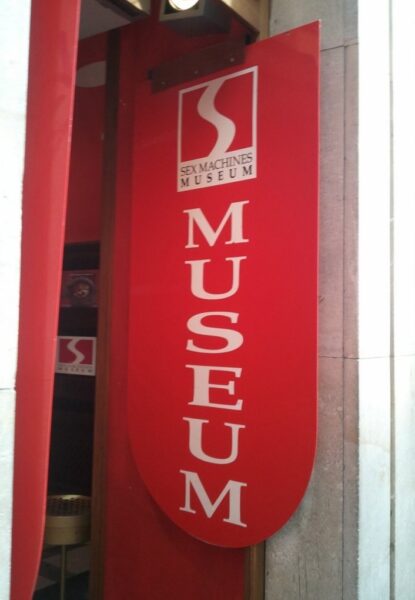
The museum is the brainchild of Oriano Bizzocchi originally from the tiny Republic of San Marino. Bizzocchi began his collection of sex related objects in the late seventies or early eighties. Over the ensuing two decades he cultivated friendships with antique dealers around the world until he had amassed a collection of more than 300 sex toys, contraptions, and objects of various configurations and uses ranging from curious to useful and from lascivious to ludicrous. The museum opened in 2002.
When you step inside the doors, you can measure yourself for free in the Love Tester
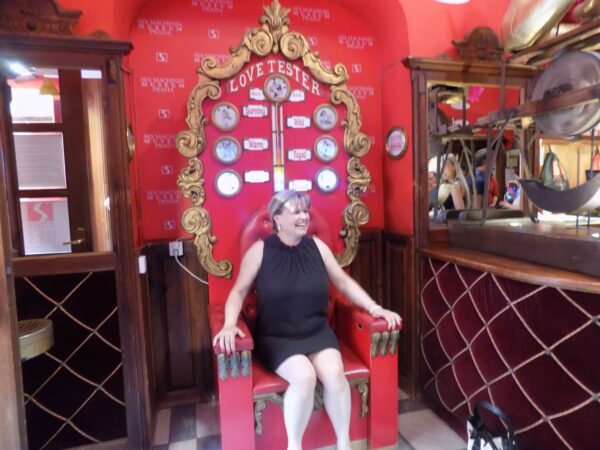
but a trip through the museum will set you back CZK 250 (about $10 when I visited).
Get ready. We’re going in!
After buying our ticket we’ll climb the stairs to the third floor and work our way down. One of the first (and largest) objects to catch my eyes (or anyone else’s I suspect) is the Siège d’amour. The adjacent sign notes that it was “made in Paris around 1890, it circulated among the most famous brothels of that time.” (I have to admit that even with the drawing and description, I still had some difficulty understanding exactly how it worked.)
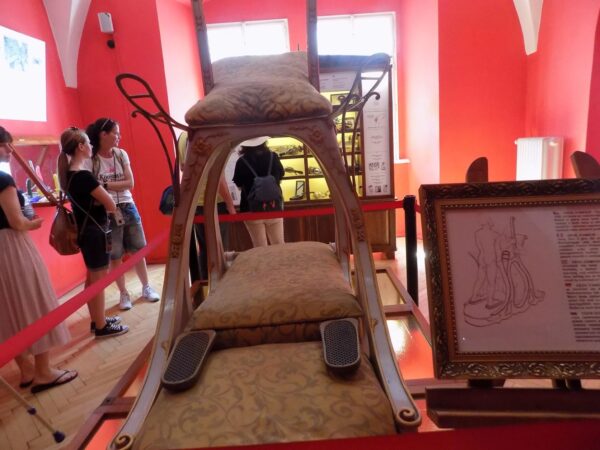
Then there was an array of phalluses. In the photo below, you see one of glass and one of brass (and my reflection in the mirror behind). Each could be filled with hot or cold liquid to vary the stimulating sensations.
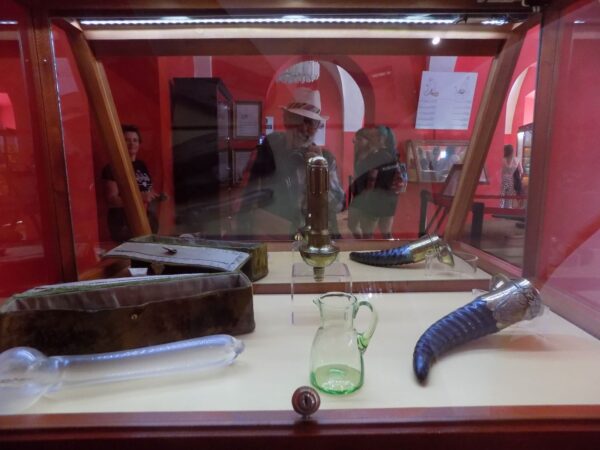
If you look closely at the horn shaped device on the right, called a godemiché, you’ll see a piece of it that’s open toward the mirror at the back of the case. Here, the woman inserted a photo of her lover to add to her stimulation. Have a change of heart and a change of lovers? No problem. Have a change of photo.
…All my symphonies.
In a previous post I touched upon Antonin Dvorak’s lifelong fascination with trains and noted that after traveling to New York he expanded that interest to steamships (okay, and pigeons). It made some sense, then, that Jana told us that he’d once said that he’d have given all his symphonies to have invented the steam engine. I encountered this interesting device in the SMM

described by the informational placard as follows:.
STEAM VIBRATOR – Steam coal-powered vibrator with acetylene variants, made by Dr. George Taylor in 1869 and used to treat hysteria. It was believed that hysteria could be treated by stimulating female genitalia, leading to the “therapeutic” orgasm of the “patient”.
At that moment I wondered if Dvorak would have retained his avidity for the steam engine if he’d known of this particular use. (After returning home I did some further research and found that according to the Antonin Dvorak website, the statement was part of a longer ‘ode to the train engine’ and was, according to that site, “I’d give all my symphonies if I could have invented the locomotive!” An important difference, I think, especially in this instance.
A Summary.
The array of devices and objects on display from examples of genital piercing jewelry, to male anti-masturbation contraptions, to the cleverly marketed vibrating vacuum cleaner, to the nightgown that allowed intercourse without the bodies otherwise touching, or to this fake camera
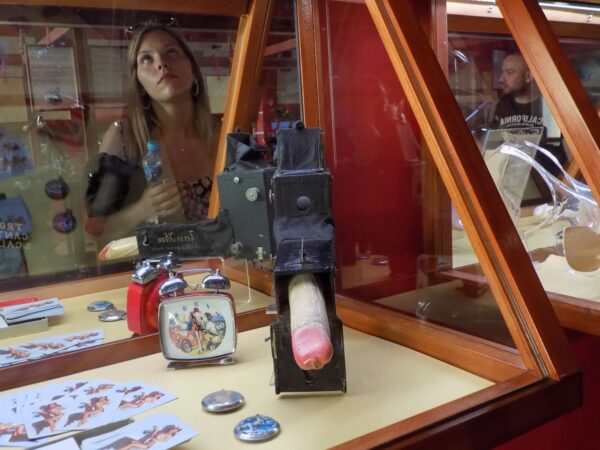
that was intended as a practical joke may not be to everyone’s taste and interest. On the other hand, if you have some curiosity about the rather inventive ways our forebears dealt with sexuality, you can understand why this little museum has survived for two decades. Here’s the link to the rest of my (NSFW) photos from the SMM.
Bonus material – Anthropological sex.
This section isn’t directly related to the SMM and also is not something I discovered while looking into the history of the museum. Rather, it’s information I happened upon while doing my research of the post When you Vyšehrad…
I noted above that Czechia and Prague are generally considered to have among the most progressive attitudes toward human sexuality of any of the former Warsaw Pact nations. The information I’m about to share might raise the question (and not entirely facetiously), “Is it in their DNA?”
It started when I was looking for information on Paleolithic humans in the area around Prague and happened across a series of 2011 articles with headlines similar to this one from NPR, “Researchers Dig Up ‘Homosexual Or Transsexual’ Caveman Near Prague.” Most of the stories were accompanied by this (or similar) photo
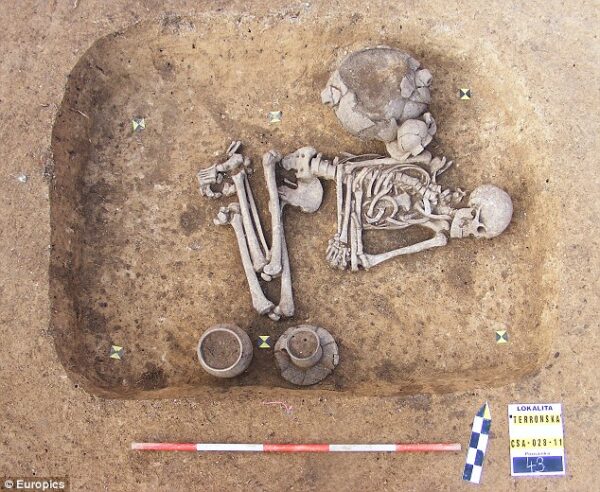
[Image of paleolithic burial from Dailymail].
Here’s the explanation: Based on the location and date of the site (3000-2500 BCE), this individual was probably from what archaeologists term the Corded Ware culture and pelvic examination determined the individual was male. However, the grave has several anomalies beginning with the positioning of the body. In this culture and during that period, men were traditionally buried lying on their right side with the head pointing towards the west; women on their left side with the head facing east. In this case, the man was on his left side with his head facing east.
Talking about this the lead researcher, Kamila Remišová Věšínová, said, “From history and ethnology, we know that people from this period took funeral rites very seriously so it is highly unlikely that this positioning was a mistake.”
The grave’s contents and lack of contents are also part of the puzzle. In an interview with Radio Prague International, Věšínová explained, “…women were usually buried with some kind of necklace made of animal teeth, mainly teeth of domestic animals, sheep, goats, dogs, but also from wild animals while men were buried with vessels and weapons.” Describing the grave she continues, “There was one skeleton here, and this skeleton was surrounded by five ceramic pots and one flint knife. That was all we found in this grave. This was really untypical because the grave did not contain any male or female grave goods.”
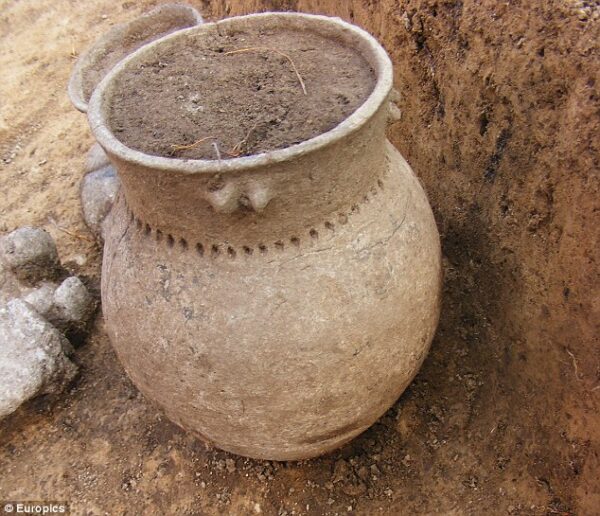
[Artifact image from Dailymail.com].
The number and positioning of the the clay pots was also unusual. Early on, even Věšínová speculated on the likelihood that “he was a man with a different sexual orientation, homosexual or transsexual.”
But do we really know?
Here are some reasons for skepticism. Doctor Lemont Dobson, a historian and archaeologist at Drury University, points out that determining the sex of a skeleton by looking at the pelvis is 90 percent accurate but not perfect so further examination could show that the body is, indeed, female and that, “There is always the possibility that the individual had some form of shamanistic role in their society. If so, the female position would be appropriate.” Even if Dobson is correct, it would explain only the body position but not the absence of items that one would expect to find in a woman’s grave or a man’s for that matter.
In her Prague Radio interview, Věšínová provided some alternative possibilities, “Well if it was a man buried in the position of a woman there could be many reasons actually, and most of them we are not able to reconstruct today. But from ethnological and other archaeological data we can consider three main interpretations: either that it was a person of ‘third gender’, meaning any sexual orientation different than the norm. Or other possibilities are that, in a village of 40 to 50 people maximum, they could do this to someone who was different in some way – any way – maybe mentally retarded or psychologically ill, of another sexual orientation or gender identity, or who was for example left-handed, or did things differently.”
While it’s almost certain scientists will never resolve the riddle, it’s equally likely that the ‘third gender’ interpretation is as wrong as it is right. Like anyone else, archaeologists and anthropologists are a product of their education, upbringing and biases and there’s a history within these sciences of drawing mistaken conclusions from burials. Still, it’s an intriguing question to consider.
Next up, a night of music at the Rudolfinum.